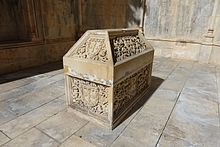John, Hereditary Prince of Portugal (1451)
Hereditary Prince of Portugal
| John | |
|---|---|
| Hereditary Prince of Portugal | |
 Tomb in Mosteiro da Batalha | |
| Born | 29 January 1451 Sintra National Palace, Sintra, Kingdom of Portugal |
| Died | February 1451 |
| Burial | Monastery of Batalha, Batalha, District of Leiria, Portugal |
| House | Aviz |
| Father | Afonso V of Portugal |
| Mother | Isabella of Coimbra |
John, Prince of Portugal (Portuguese: João; 29 January[1] – February 1451) was a Portuguese infante, son of Afonso V and Isabella of Coimbra.[2] He was born heir to the throne in 1451, but he died young during the same year. The title of Prince of Portugal then passed again to Infante Ferdinand, Duke of Viseu, his uncle.
References
John, Hereditary Prince of Portugal (1451) House of Aviz Cadet branch of the House of Burgundy Born: 29 January 1451 Died: ? 1451 | ||
| Preceded by | Hereditary Prince of Portugal 1451–1451 | Succeeded by |
- v
- t
- e
The generations indicate descent from Afonso I, and continues through the House of Aviz, the House of Habsburg through Infanta Isabel, Holy Roman Empress and Queen of Spain, and the House of Braganza through Infanta Catarina, Duchess of Braganza.
- João, Prince of Portugal
- João II
- Infante João, Duke of Viseu
- Infante Diogo, Duke of Viseu
- Manuel I
- Afonso, Prince of Portugal
- Manuel, Prince of Portugal
- Filipe, Prince of Portugal
- João Manuel, Prince of Portugal
- Infante Duarte, Duke of Guimarães
- Filipe III§
- Infante Carlos§
- Cardinal-Infante Fernando§
- Infante Alonso§
- None
* also an infante of Castile and León, Aragon, Sicily and Naples, § also an infante of Spain and an archduke of Austria, # also an infante of Spain, ‡ also an imperial prince of Brazil, ¶ also a prince of Saxe-Coburg and Gotha, Duke in Saxony, ◙ also a prince of Braganza, ¤ title removed in 1920 as their parents' marriage was deemed undynastic, ƒ claimant infante











